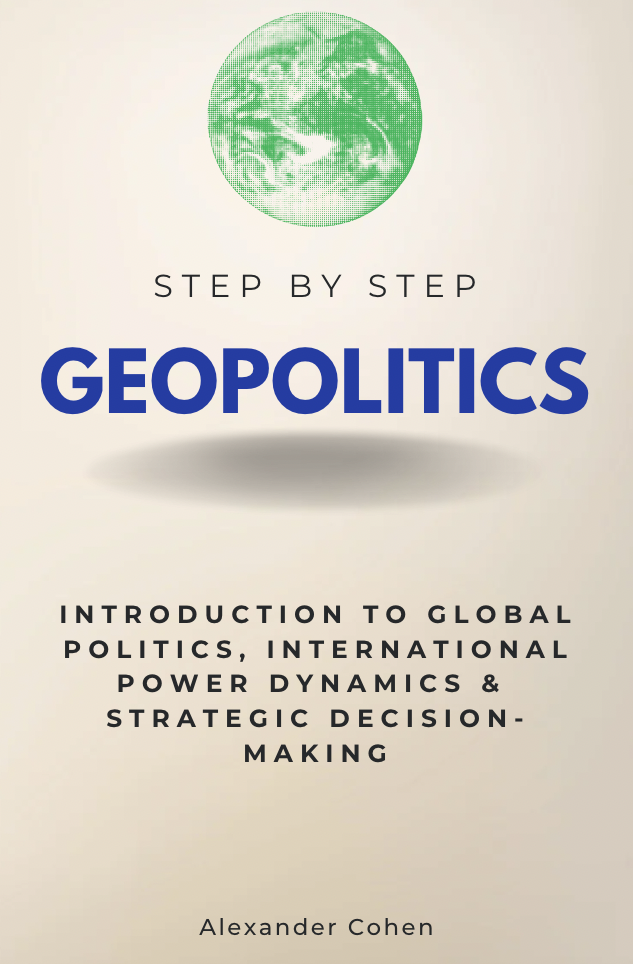In “Geopolitics Step-by-Step: Guide to Global Politics, International Power Dynamics & Strategic Decision-Making,” Alexander Cohen looks at the complexities of geopolitics, providing an accessible guide that caters to a wide audience.
Whether you are a student, policymaker, business leader, or an enthusiast of global affairs, this book can help understand the dynamics that shape our world.
It is, however, aimed at a more introductory level.
Overview
From the outset, Cohen sets the stage with a robust introduction to the fundamentals of geopolitics. He explains the definition, scope, and importance of geopolitics, tracing its historical evolution and highlighting the critical role of geography in shaping political and economic strategies. This foundational knowledge is important for readers to grasp the subsequent, more complex discussions.
The book is structured into clearly defined sections, each going into key aspects of geopolitics. Cohen begins by exploring the essential theories of international relations, including realism, liberalism, and constructivism. He explains these theories with clarity and provides practical examples that illustrate their application in real-world scenarios. This approach not only aids in comprehension but also demonstrates the relevance of these theories in contemporary global politics.
A significant strength of “Geopolitics Step-by-Step” lies in its detailed analysis of power dynamics. Cohen distinguishes between hard power, soft power, and smart power, elucidating how countries leverage these forms of power to influence international relations. He discusses economic power, military might, and strategic alliances, providing a nuanced understanding of how nations navigate the global stage. The inclusion of case studies, such as the economic rise of China and the strategic maneuvers of the United States, adds depth to this analysis and offers readers concrete examples of these concepts in action.
Cohen also goes into the roles of both state and non-state actors in global politics. By examining the influence of international organizations, non-governmental organizations (NGOs), multinational corporations, and terrorist groups, he provides a comprehensive view of the diverse players that shape geopolitics. This broad perspective is essential for understanding the nature of global interactions.
One of the standout features of the book is its focus on regional geopolitics. Cohen dedicates chapters to the geopolitical dynamics of Asia, Europe, the Middle East, Africa, the Americas, and the Pacific. Each chapter provides an in-depth look at the historical contexts, cultural influences, and strategic interests that define these regions. This regional approach not only enhances the reader’s understanding of global politics but also highlights the unique challenges and opportunities faced by different parts of the world.
In addressing modern challenges, Cohen doesn’t shy away from discussing pressing issues such as climate change, energy security, and the impact of emerging technologies. His examination of these topics is fairly thorough and thought-provoking, offering insights into how these challenges influence geopolitical strategies and decision-making. The discussion on the role of information warfare, disinformation, and propaganda is particularly relevant in today’s digital age, where information has become a critical tool in shaping public opinion and geopolitical narratives.
The book concludes with a focus on strategic decision-making. Cohen provides practical tools and methods for geopolitical analysis, scenario planning, and risk assessment. These chapters are particularly useful for readers involved in policymaking or strategic planning, as they offer concrete techniques for navigating global politics.
Overall
“Geopolitics Step-by-Step” is both clear and accessible. Cohen’s writing is clear and engaging with no walls of text and is beginner-friendly, making complex topics understandable without oversimplifying them.
The use of real-world examples and historical case studies enriches the content and provides a tangible connection to the theoretical discussions.
In summary, “Geopolitics Step-by-Step: Guide to Global Politics, International Power Dynamics & Strategic Decision-Making” is a great read for anyone looking to deepen their understanding of geopolitics. It combines theoretical knowledge with practical insights, making it an good addition to the library of students, professionals, and enthusiasts of global affairs.
It’s bound to be overly introductory for those who are more well-versed in geopolitics.
Overall, a great intro to geopolitics, international relations, and the strategic decision-making that shapes global affairs.
Overall Rating: 4.8/5


